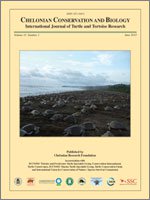When preparing management plans for species at risk, conservation practitioners need information on the habitat requirements of those species. In environmental extremes, the fitness of ectotherms is tightly linked to thermoregulation, as all physiological processes are temperature dependent. In an effort to better quantify the habitat requirements of Blanding's turtles (Emydoidea blandingii), a species at risk, at the northern extreme of their range, we quantified the thermoregulation patterns of adult males and gravid females during the active season. Turtles exploited their thermal environment significantly more in early season than in late season. Although basking allowed turtles to reach the highest daytime temperatures, surface water was the habitat with the highest thermal quality overall. Although not statistically significant, gravid females tended to maintain higher mean and maximum shell temperatures throughout the active season. Gravid females also spent substantially more time basking than males throughout the active season. Our results highlight the importance of stratifying field observations and thermoregulation data by reproductive class and time. Differences in behavior and thermal habitat requirements between reproductive classes and season must be considered in management plans for conservation efforts to be effective.
How to translate text using browser tools
1 June 2012
The Effects of Sex and Season on Patterns of Thermoregulation in Blanding's Turtles (Emydoidea blandingii) in Ontario, Canada
Catherine S. Millar,
Jeffrey P. Graham,
Gabriel Blouin-Demers
ACCESS THE FULL ARTICLE

Chelonian Conservation and Biology
Vol. 11 • No. 1
June 2012
Vol. 11 • No. 1
June 2012
basking behavior
Chelonia
Emydoidea blandingii
indices of thermoregulation
Reptilia
Testudines
Thermal ecology




